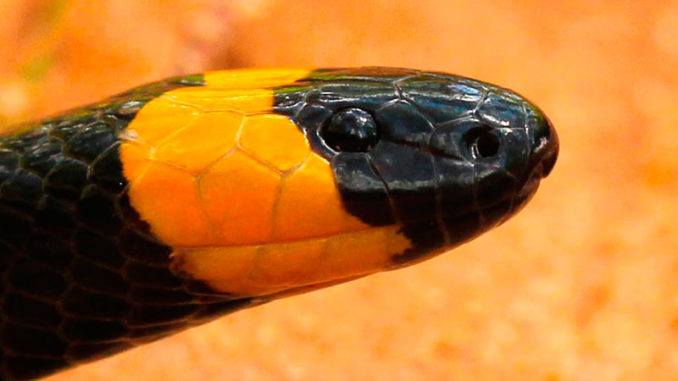
Love them or hate them, snakes are a part of life in Louisiana. I manage a snake-identification and education page on Facebook called Louisiana Snake ID. My passion for snakes began at a young age as my mother helped me learn about them and catch the ones in our yard. I became more and more fascinated with them over the years, having caught ribbon snakes, kingsnakes and water snakes.
After graduating from LSU, I married my high-school sweetheart; we have two sons. I’ve shared my passion for the outdoors with them since they were born and have taught them to respect snakes rather than fear them. Children who are taught to fear snakes in general usually grow up to be adults who say things like “The only good snake is a dead snake.” This is a common phrase that couldn’t be farther from the truth, as all snakes, even venomous ones, serve a vital purpose in the ecosystem that helps to keep our hunting and fishing grounds healthy.
Education is important
People fear things they don’t understand, so we thought if we could help them learn more about snakes then they would be less likely to kill them. Our Louisiana Snake ID page was created in 2017 for this purpose, and since then, we have won over countless numbers of people who used to believe that common, yet untrue mantra mentioned above. We respond to dozens of messages daily from people needing help identifying snakes and have more than 12,000 followers. Our Facebook LIVE videos have been getting tens of thousands of views, and we have up-close encounters with snakes on our YouTube channel: LA Snake Boyz. We are so thankful social media gives us a platform to educate and share our “Snake Life” with others who want to learn.
You can visit www.louisianasnakeid.com for all of our social media and contact information.
Venomous snakes
Forty-eight species of snakes can be found in Louisiana, but only seven of them are venomous.
There are three different venomous rattlesnakes. The rattles on the end of their tails are made of interlocking rings of keratin, which is the same material our fingernails are made of. Similar to a dog growling or a cat hissing as a warning, a rattlesnake will vibrate its tail to make a distinct and chilling sound in an effort to make the potential threat go away. As part of the pit viper family, they use heat pits to sense their prey’s body heat. They are typically ambush predators that get close, then curl up and wait for the prey to cross their path. Their venom is hemotoxic, which kills blood cells and causes tissue damage. While they have elliptical (cat-eye) pupils, pupil shape is unreliable for a few reasons:
- You have to get within striking range to see their pupils.
- Pupils dilate in low light, appearing round.
- Many venomous snakes have round pupils.
Eastern diamondback rattlesnake (Crotalus adamanteus)
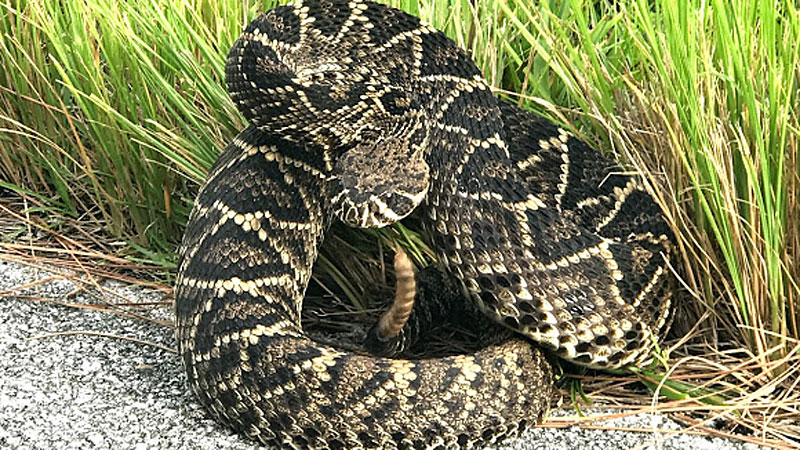
It’s the largest venomous snake in North America, with a diet of rodents and occasionally birds. Usually a brown to brownish-yellow color overlaid with a series of dark, brown to black diamonds along its spine that are outlined by a row of cream or yellowish scales. Generally between 3½ and 5½ feet long, they can grow to better than 7 feet. Due to habitat destruction and predation by humans, approximately five have been spotted in our state in the past decade in the eastern Florida parishes. These snakes are listed on the critically endangered list.
Timber rattlesnake, aka canebrake rattlesnake (Crotalus horridus)

It’s diet consists of rodents, squirrels, rabbits, birds and other small animals. Colors can range from a light tan/grey to darker browns, but its identifying feature is the black chevron, or “V”, pattern along its back that points to the tail. You may hear them called “canebrake” rattlesnakes in areas with sugar cane fields. It can reach up to 6 feet in length but average around 4½ feet as adults. They often won’t rattle when you initially come upon them. Found all over Louisiana, but are uncommon in the southwest portion of the state and along the coastline.
Pygmy Rattlesnake (Sisturus miliarius)
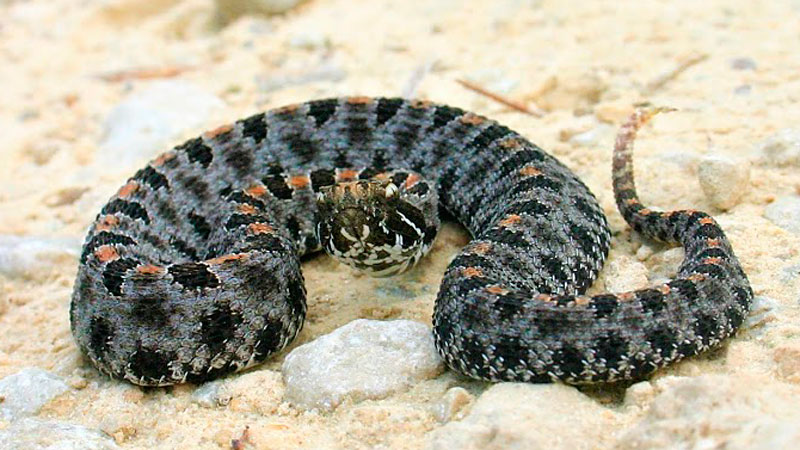
The smallest rattlesnake in the world, the pygmy rattlesnake’s diet is mice, lizards, snakes, frogs and birds. It can vary in color, but is typically a silver or gray background color with equally spaced dark brown or black spots down the back and sides. It has a dark stripe that runs through the eye and extends to the back of the head and may have a faint orange stripe down the center of the back. Average adult length is about 15 inches, with a maximum length of only 25 inches in Louisiana. Found mainly in the Florida parishes and western portions of Louisiana, but have become increasingly rare in the state. They do not occur along the coast or on the western edges of the Mississippi River.
Eastern copperhead (Agkistrodon contortrix)
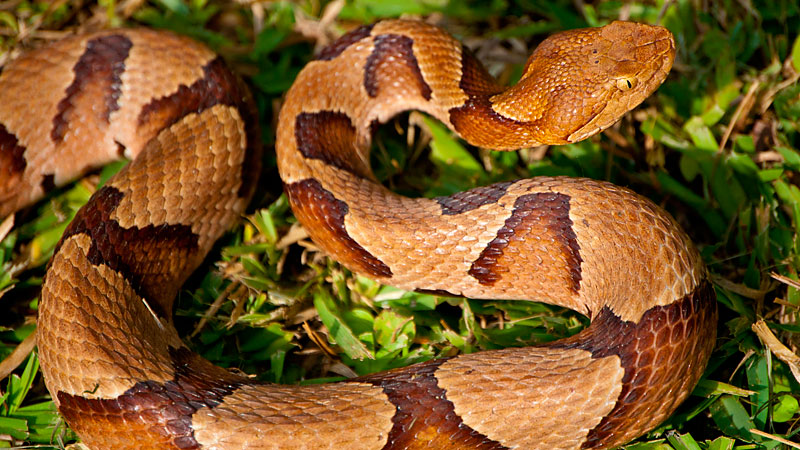
The eastern copperhead is one of the most-common and easily recognized venomous snakes in Louisiana. This species occurs across the state, except for the coastline and prairie of southwest Louisiana. Adults reach a maximum length of about 50 inches, with the average adult about 36 inches. The copperhead is characterized by a light grey to orange background color with a darker orange or brown pattern along the entire body that is often and accurately described as “Hershey Kisses” when viewed from the side, or hourglass figures when viewed from above. Their heads are typically slightly darker than their bodies. Juvenile copperheads will have a bright yellow/green tail tip that they use as a lure to attract insects, frogs and small mammals. This brightly colored tail will fade away as the snake grows and approaches adult size.
Coral snakes
We have two types of venomous coral snakes. They are NOT members of the pit viper family but rather the Elapidae family with short, fixed, hollow fangs in the front of their upper jaw. Coral snakes are highly secretive, spending most of their lives under logs and leaves or underground. They are small and slender with a blunt head that is solid black to just behind the eyes, which have round pupils. While their mouths are not very large, they do inject a neurotoxic venom that causes paralysis and respiratory failure in their prey. Their main diet consists of small snakes, lizards and the occasional rodent. They have sometimes been known to cannibalize their own species. Unlike the other venomous snakes in the United States, coral snakes lay eggs in the summer that typically hatch in the early fall. Coral snakes are most often brightly colored in red, yellow and black bands, but as colors vary for dogs or cats of the same species, some coral snakes display very dark reds, light yellows to almost white, and/or very narrow bands, which make the “red touches yellow/red touches black” rhyme most people were taught as kids unreliable. Harmless non-venomous scarlet snakes, king snakes and milk snakes are also similarly colored, so your best bet if you come across a brightly colored snake is to simply leave them alone. The main difference in these two is the locations in which they are most likely to be found.
Texas coral snake (Micrurus tener)
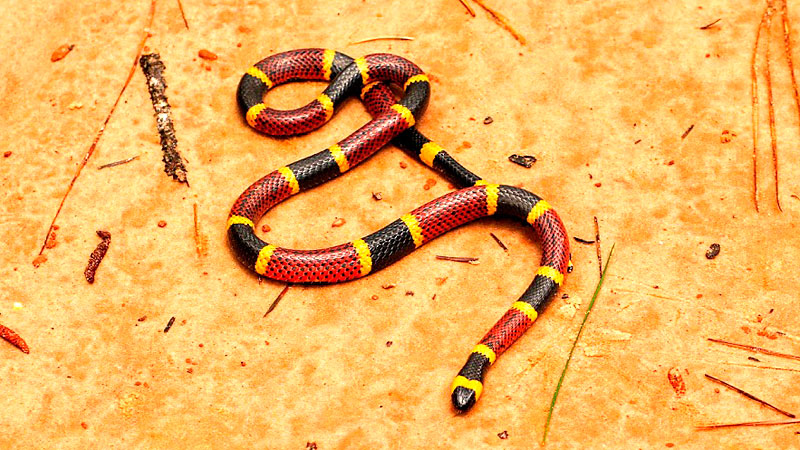
Average around 2 feet long and are found in much of the southwest, central and northern portions of Louisiana
Harlequin (aka Eastern) coral snake (Micrurus fulvius)
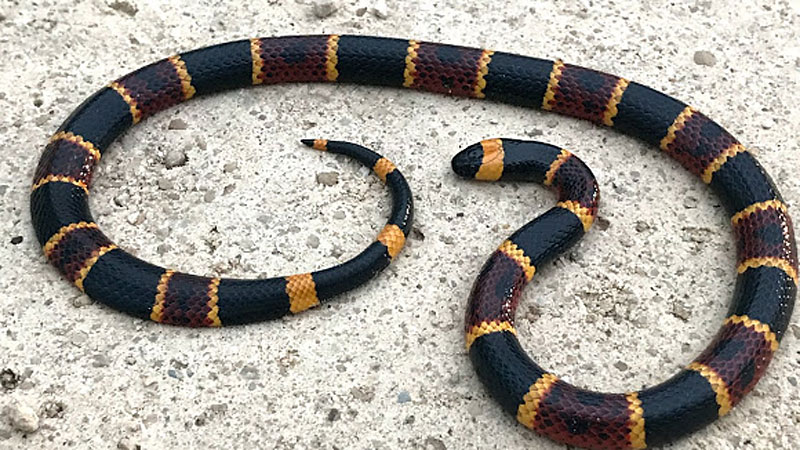
These snakes are typically 18 to 30 inches long but have been found to reach close to 4 feet in length. Limited to the eastern Florida parishes of Louisiana.
Northern cottonmouth water moccasin (Agkistrodon piscivorus)

These very common yet often misunderstood snakes are the world’s only semi-aquatic viper. Cottonmouths have become legends of the swamps, but like most good fishing and hunting stories, the details have been greatly exaggerated. People say they will chase you, but I’ve interacted with countless moccasins and worked with others who study snakes for a living, yet we have not been able to get a single one to chase us. Typical moccasin behavior is to curl into a coil and proudly display their bright white mouth as a deterrent to potential threats, then slither away when the coast seems clear. A moccasin may be intrigued by your fish stringer or move in your direction, but this behavior is not “chasing.” Chasing implies it will follow as you run in different directions.
Juvenile moccasins also have a bright, neon-green/yellow tip on the end of their tails, and they ARE NOT more dangerous than adults, because they are capable of regulating their venom output. Adults average 30 to 48 inches in length, with a record specimen reaching 74½ inches. Moccasins have a dark “Zorro mask” line that runs from the tip of their nose and through their eyes. It’s typically outlined by a lighter colored line on top and bottom, and unlike nonvenomous water snakes, their eyes are not visible from the top of their heads. Moccasins are avid swimmers, both on top of and under the water, with a diet consisting of fish, frogs, rodents and even other snakes. They are found throughout nearly the entire state of Louisiana.
So what should you do if you are bitten by a venomous snake?
- Stay calm;
- Seek medical attention immediately.
- Remove your watch or any jewelry near the bite that may restrict blood flow due to swelling.
Do not bring the snake to the hospital with you. Medical personnel only need to know whether it was a coral snake or not, as there are only two types of antivenom administered in the United States — one for coral snakes and the other for all vipers, including rattlesnakes, moccasins and copperheads.
Snakes are typically docile, but I would not advise anyone to approach them, simply give them space and snap a picture from a safe distance while showing them the respect they deserve.